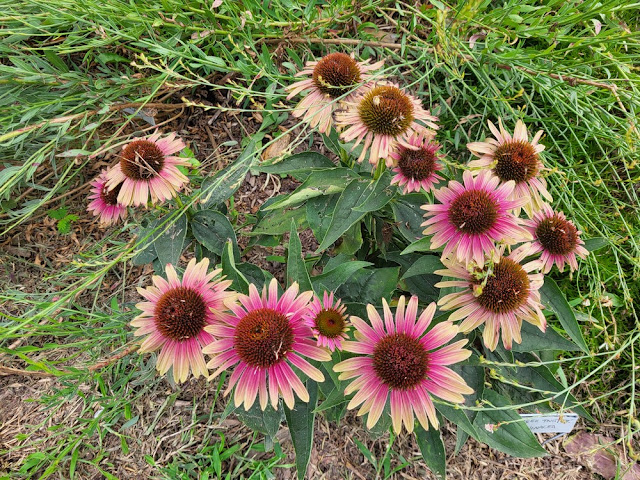Papilio polyxenes - Black swallowtail butterfly larva on dill
Once in a while, 'Purple Ruffles' basil will produce a plant that isn't all purple. This year, I only had two plants, and both were purple and green.
The long, sweet peppers are starting to color.
Currently harvestable:
'Tasty Bites' mini cantaloupe, 'Supersweet 100' cherry tomatoes, 'Marketmore' cucumber, 'Carmine Splendor' okra, 'Merveille de Quatre Saisons' lettuce, 'German Johnson' tomatoes
My experiment with growing potatoes in straw was a flop. Somebody ate on the ones that grew properly:
That was just one plant. The other plants didn't do anything. Or if they did, this was it:
My carrots were also a failure. Some of the problem may have been the drought. Ya think? They and the potatoes were planted away from the main garden, and I need to hook up two hoses if I'm going to get far enough with the water to assist them. It was so darned hot so much of the time, that I couldn't be bothered.
The roses are not bad, but they could have used more watering, too. I've been able to keep them from a lot of Japanese beetle damage, but at the cost of spraying them every couple of days with Sevin insecticide. Today, I noticed aphids coming on one of the shrubs. Last year, the aphid situation got away from me, and I hardly had any roses.
'Mother of Pearl'
'Grande Amore' on a very humid morning
'Razzle Dazzle'
'Green Twister' Echinacea
'Green Twister' is still going strong, but 'Cheyenne Spirit' is done blooming.
'Cheyenne Spirit' in mid-June
I planted 'Cheyenne Spirit' to add some stand-out color to the perennial bed, and they kind of overdid it.
Sadly, 'Fiery Meadow Mama' Echinacea and 'Cherry Brandy' Rudbeckia didn't make it past last year's flooding.
Echinaceas are, of course, a coneflower, and so are Rudbeckias and Ratibidas, all of which are in the large wildflower plot adjacent to my garden. Most coneflowers are perennials.
The more colorful varieties may be relatively new breeds. Old fashioned Echinacea, purple coneflower, is very common, as are the yellow varieties of coneflowers that are normally Rudbeckias. If you can't decide which you're looking at, you are safe calling purple coneflowers Echinacea and yellow ones Rudbeckia or Ratibida. Or you can just keep calling them all coneflowers. Some familiar Rudbeckia are called Black-Eyed (Rudbeckia hirta) and Brown-Eyed (Rudbeckia triloba) Susans.
Ratibidas are more distinct in that they are less coarse in stem and leaf and have flowers on long, leafless stalks and heads that are generally elongated. Think of Mexican Hat and Grayhead Coneflower.
Emerging Rudbeckia
Brown-Eyed Susan (Rudbeckia triloba)
To close out (as they are finishing blooming) - a close look at 'Casablanca' oriental lily:




















0 comments:
Post a Comment
Many thanks for your interest and your comments.